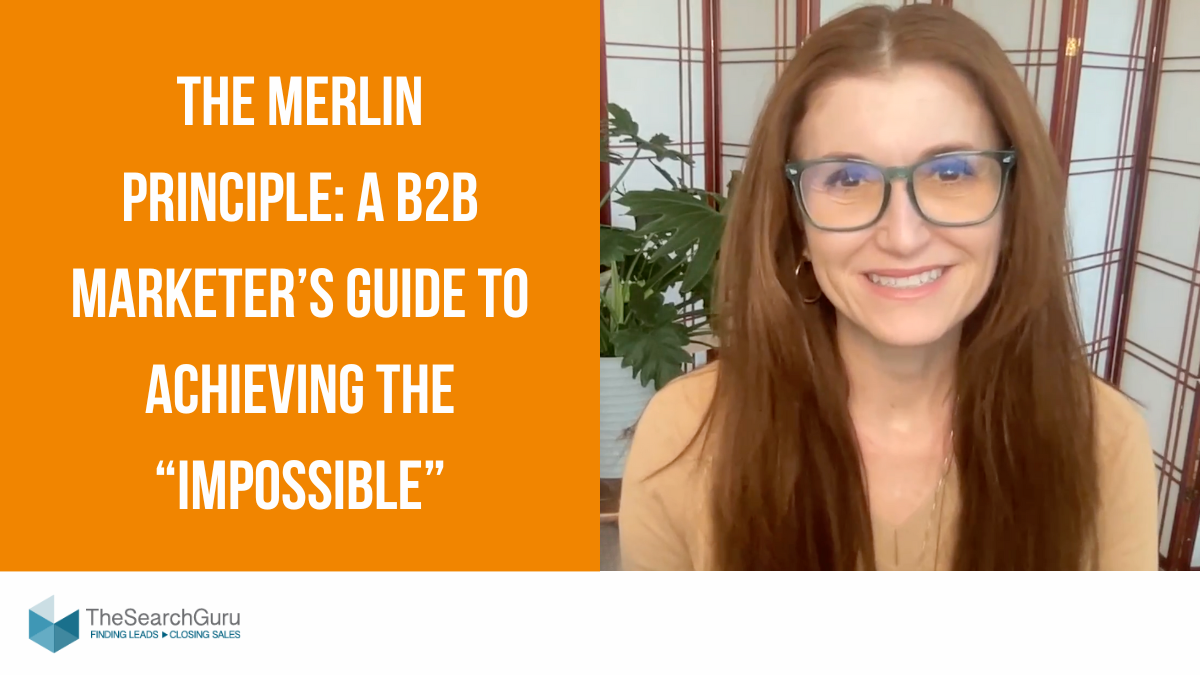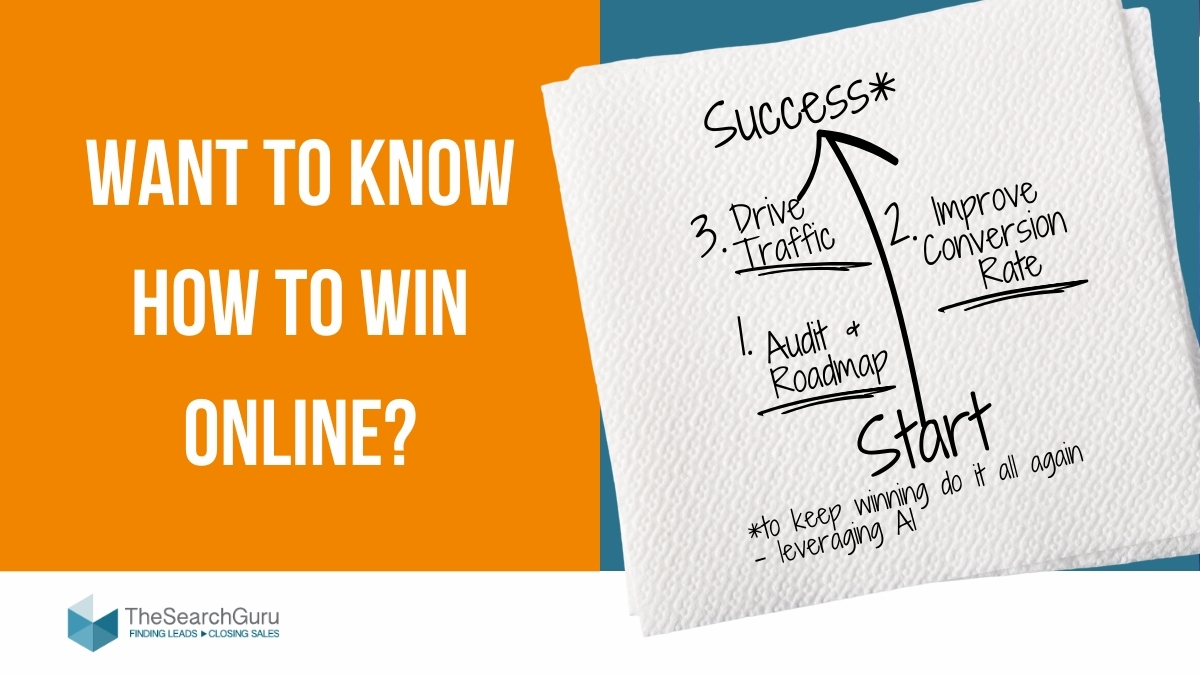The pandemic compounded every content marketer’s #1 problem: lack of time and resources.
Top content marketers, when faced with crisis, revisit strategies. They take uncertainty, disruption, changing customer behavior and other complexities and assess and adjust, even when our #1 problem may have just reached a new level.
How to cope, maintain and even grow, is a tall order. And those are the games you’re playing. Here are 9 ways to do just that.
#1 Obstacle Faced By B2B Content Marketers: Working with limited resources.
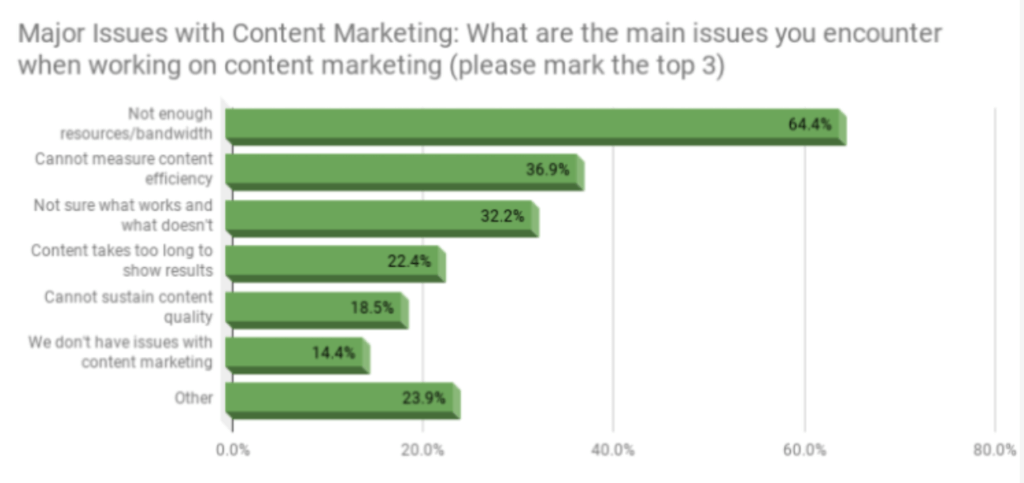
Source: Content Marketing Research, 2019-2021, The Search Guru
This list came out of real world, hands on, during crisis, work, as the team at The Search Guru (TSG):
- Served clients
- Provided work sessions for dozens of top marketers
- Surveyed more than 575 top content marketers
All confirmed shortages of time and resources are their #1 impediment. And the best way to get more resources is to show results, so, let’s get right to it:
The top 9 fastest ways to win leads and sales via B2B content marketing (even when resources are limited) for 2021.
Shortlinks:
- Prioritize activities, starting with low-hanging fruit. Improve existing content not yet ranking well enough.
- Check available resources and match them to work that fits.
- Improve already well-performing content by adding FAQs.
- Find your top five landing pages that bring organic traffic to your site and optimize those, further.
- Check what your competitors are doing.
- Find which articles perform best on social media to optimize other articles accordingly.
- Choose to improve conversion rate, rather than work on new content.
- Find your top five landing pages that have the highest click-through rate and further optimize them.
- Only market to the right target—find your niche and focus your keywords on that niche.
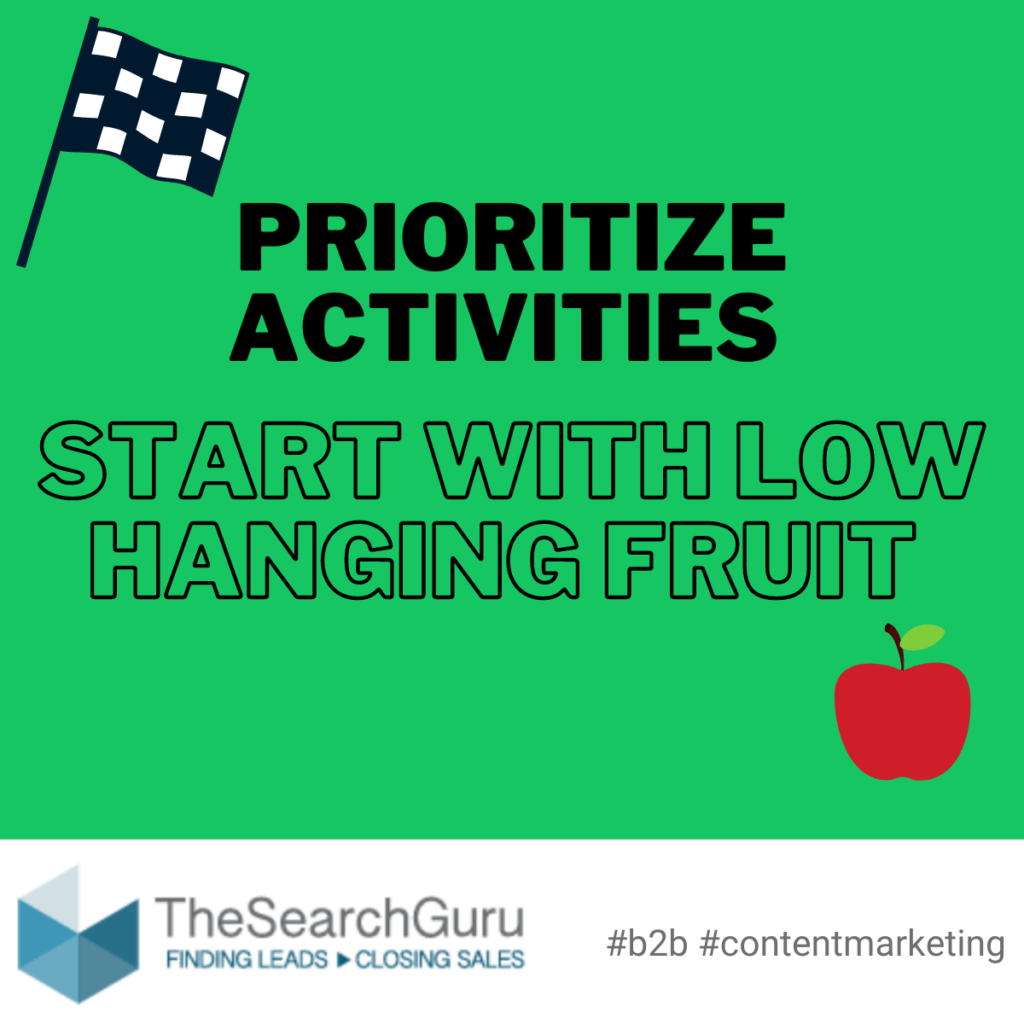
1. Prioritize activities, starting with low-hanging fruit. Improve existing content not yet ranking well enough.
Why
-
- Did you know that there are some keywords with a high search volume, for which you rank on page 2 or 3 in Google’s index, that do not appear in your reports because you are not currently getting sufficient traffic from them?
- Top B2B content marketers know that optimizing existing content for ranking for those keywords means:
- Fast access to free search traffic;
- From high-volume keywords;
- For which you’re already ranking but not yet getting traffic (because you are ranking too low currently).
How
-
- Use tools like SEMrush, Ahrefs, and Moz:
- To identify high search volume keywords for your website;
- To find where you’re currently ranking in positions 7 to 30;
- To show you where each page is ranking for each keyword;
- NOTE You can use Google Search Console, but you will need to take additional steps to pull up the ranking pages.
- Choose the pages that are important for your business and optimize them for better rankings and conversions by:
- Expanding copy with related subtopics;
- Improving the UX with appropriate headings and listings to make it easier for users to scan through the copy and find what they are looking for;
- Adding conversion elements, such as CTA (call to action) buttons, testimonials, and FAQs;
- Improving meta-information;
- Adding schema, etc.;
- Optimizing those pages generates the chance to pull them up to page 1 in Google SERPs, which equals more free traffic.
- Use tools like SEMrush, Ahrefs, and Moz:
Example: YellowDogFlyFishing.com has 1,000 keywords where they are ranking positions 11-20. They are close to page 1 where they can start getting traffic from these keywords, but right now they get less than 0.5% of available traffic. If they optimize the pages that are ranking, they might reach page 1 and start gaining organic traffic from those keywords.
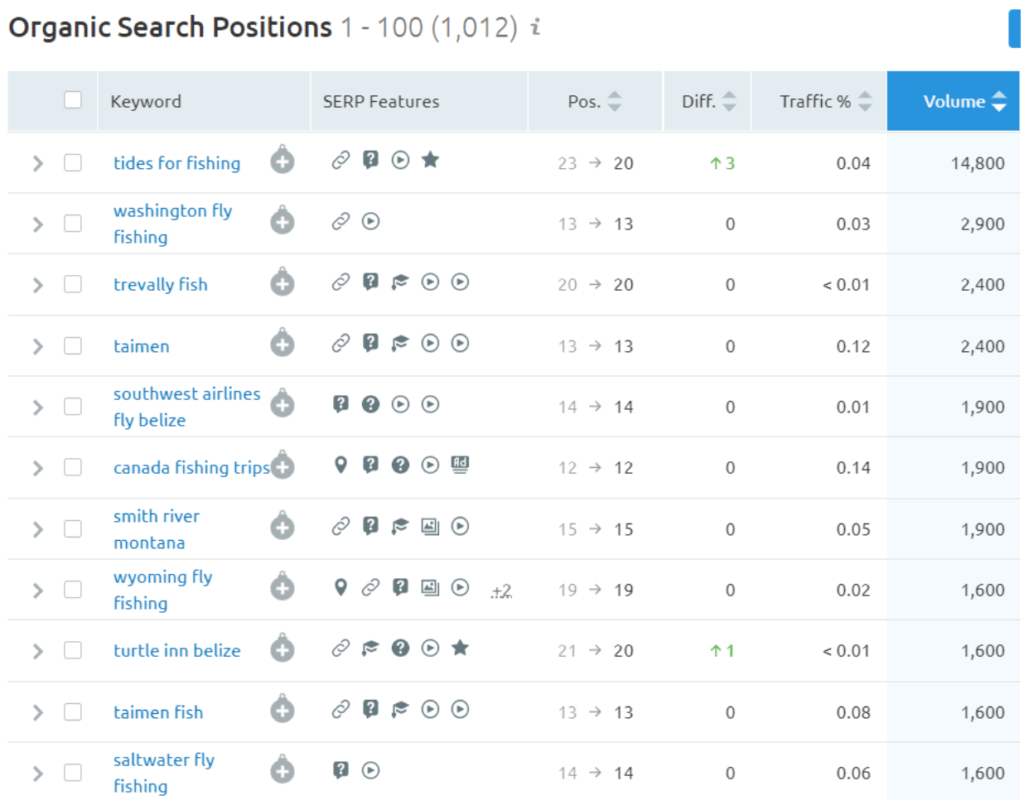
Source: SEMrush

2. Check available resources and match them to work that fits.
Why
-
- Content marketing is a slow process, so it’s wise to prioritize for quick wins first. Performing an internal content audit (top resources and low-hanging opportunities) and competitive research will give you data on what’s working for you overall and in your market niche.
How
-
- Analyze the results you’ve gathered. Present them to your team and brainstorm. Here are some sample questions for the discussion:
-
-
- Where does it make the most sense (from a business perspective) to invest?
- What resources do we have?
- What would be easiest to optimize or produce?
- What would have the biggest impact?
- What would support the current campaigns we are running?
-
Example: We recently spoke with a client who is creating a brand new site for a business they’ve been running for 2-3 years. The site has no backlinks and no content. We didn’t see opportunities in SEO to gain organic traffic and so were not pushing for it.
But, then the client mentioned they can do interviews with well-known names in their industry, experts, who they knew personally. And that it would be very easy to do so. Discovery! A content resource that could be used, even when resources are limited!
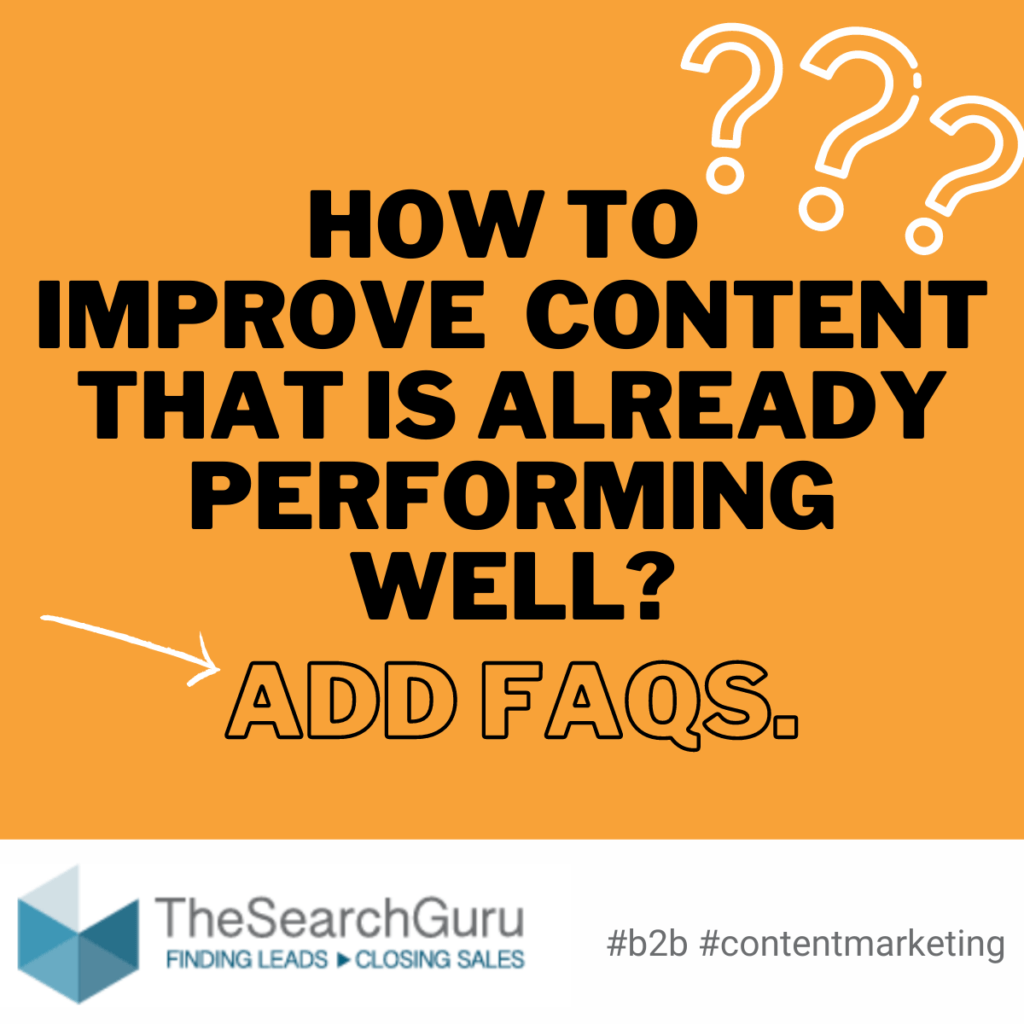
3. Improve already well-performing content by adding FAQs.
Why
-
- An easy way to produce great content is by using what you currently have. Mine currently available resources, such as email and ticketing systems for answers to those frequently asked questions.
How
-
- How to produce content from sales communication: If you review your sales communication, you will likely see that there are more than a few great questions from potential customers as well as some great answers provided by your sales team. This communication could be easily turned into useful, ranking content.
- How to produce content from support communication: If you’re providing support for the services and products you offer, you will most likely have tons of support communication already available. By combining and editing this information and turning it into knowledge/how-to articles as well as FAQs, you can release a considerable amount of high-quality content at a very good speed. To make the FAQ content even more appealing to the search engines, you can add FAQ schema markup, which may help you earn more space in results pages and improve click-through rate (CTR).
Example: A client, a provider of certifications and education, was not supporting a blog. They were interested in content strategy for lead generation, but weren’t sure if they had the resources to invest in blog content. After some discussions and research, we found learning materials in PDF format, which had not been indexed in Google. The client provided them for their customers to download to help them study, the customer then paid a fee in order to take the test for certification. We discussed releasing those PDFs for search engine crawling as that means high-quality content for the brand.

4. Find your top five landing pages that bring organic traffic to your site and optimize those, further.
Why
-
- Continuous “free” traffic: Organic traffic is important and free, unlike paid traffic, where when you stop the ads, the traffic stops. Organic traffic resources, once created, continuously deliver, often without much more effort needed from you. With the top producers, it may be worth circling back to them to see whether you can enhance them further.
- Grow organic traffic by doing more of what works.
- Improve existing pages that are close to the top rankings in Google search results.
- Plan on creating new pages following the examples of the top pages you’ve identified.
How
-
- Use your analytics tool (for Google Analytics, go to Acquisition > Channels, click Organic and then select Landing pages; list in descending order by Users or Sessions) or use a third-party resource, like SEMrush, Ahrefs, or Moz, to identify the top pages that bring in organic traffic.
- Analyze the top pages to see what elements contribute to their excellent performance, e.g.:
- Page title and meta-description;
- Length of content;
- Content structure—is the content easily scannable (because we know visitors don’t read all the content, they scan the page and find the section that is of interest to them):
- Headings and subheadings?
- Ordered and unordered listings?
- Stand-out sections, like quotes, tweet this, etc.?
- Are there elements like:
- Images and videos?
- Charts and diagrams?
- Interactive elements?

5. Check what your competitors are doing.
Why
-
- There’s no need to reinvent the wheel—start with what works in your market and make it better and your own.
- See where competitors get their organic search-and-paid search traffic:
- See which keywords work for them;
- See what content they have optimized enough to rank in the top positions;
- See which pages they use in their paid ads.
- See where they got their backlinks:
- What content wins backlinks?
- Which sites link to them?
- See what content works for them on social media and what content they boost on social media.
- See examples of the CRO (conversion rate optimization) solutions they’ve implemented.
- Analyze the data and adapt the ideas and strategies that make sense for your business too without the need for too many resources.
How
-
- Use tools like SEMrush, Ahrefs, or Moz for researching competitors’ search traffic, paid searches, and backlinks, Use tools like BuzzSumo for social media engagement or for “review product” or service pages for CRO solutions.
Are you interested in your competitors’ digital strategies?
Reviewing the competitive landscape is the fast track to discovering and implementing proven b2b digital marketing tactics. Use our step-by-step
Competitor Analysis template:
Example: A client was concerned about decreasing organic traffic and we checked what competitors are doing. We discovered that competitors were getting a good amount of traffic from general informative articles, which our clients didn’t consider worthy of writing.
General content means top of funnel content, the majority of readers there won’t be your exact target audience. Still, it might mean students, which could be future clients or influencers, who will someday help with decision making or be decision makers. In the end, these articles result in traffic which increases your domain authority.

6. Find which articles perform best on social media to optimize other articles accordingly.
Why
-
- To warm up leads faster: Even if social media is not a top converting channel, note that people typically need more than five interactions with a brand before they decide to become a customer—recognize that social media is a channel your prospects interact with, and your brand being there/in front of them helps accomplish this warm–up.
- Expand your reach: Social media engagement in the form of likes, comments, and shares exposes your brand to new audiences that are similar to the ones you already have.
How
-
- Use the BuzzSumo tool to see which articles had the most engagement in Facebook, Twitter, Reddit
- In your analytics tool you can see whether you got clicks from social channels (in Google Analytics, go to Behavior > Site content > Landing pages and add secondary dimension source in order to filter the network you’re interested in/converts best for you).
- See what makes those articles better and do the same for all your articles

7. Choose to improve conversion rate, rather than work on new content.
Why
-
- Existing articles are a gold mine—they are already producing results and there are tools (e.g., SEMrush) that will show you for which keywords they already rank. You can improve the results these articles produce by expanding the content to better match the keywords users type in to search for related information.
- Some pages might have a low absolute amount of traffic, but might be converting better than others. See if there are pages like this on your website. Examples of such pages may be customer case studies or stories.
- Then, there are likely pages that have a high traffic volume, but their conversion rate is way better than the average for the website.
How
-
- Check both types of pages and see what makes them special and much better converters than others; for example, look for elements like:
- Sections that are unique to these pages;
- CTA (call to action) buttons;
- Forms.
- Check whether you can implement any tactics from them on other important pages, e.g., a CTA, a testimonials section, or a well-optimized form, that may lead to an overall improvement of your conversion rate.
- HOW—Use your analytics tool (for Google Analytics, go to Acquisition > Channels, click Organic and then select Landing pages and order by Conversions).
- Check both types of pages and see what makes them special and much better converters than others; for example, look for elements like:
Example: CRO is not only about changing a button color and improving header copy. It is about understanding how to approach your prospects with the right message. Here at TSG we discovered that the first call we have with clients is very important and very hard to get. That’s why we started offering free work sessions for anyone who’s interested in the tips we offer weekly on LinkedIn. This shift helped us make great progress especially during the lockdown period, where everyone was open to free advice.

8. Find your top five landing pages that have the highest click-through rate and further optimize them.
Why
-
- Pages with a higher click-through rate (CTR = clicks/impressions) are the pages showing in the search results that get more clicks than average.
- If you can manage to improve your CTR throughout your most important pages, that will equal more free traffic—i.e., without needing to pay for it or invest in creating new content.
- Analyze high CTR pages and see what makes them special and attractive to users to encourage click-throughs. Check things like:
- Meta–description;
- Page title;
- Call to action;
- Listings/schema elements that help them rank as Google-rich snippets;
How
-
- You can identify high CTR pages via Google Analytics: Go to Google Analytics > Acquisition > Google Search Console (make sure you’ve connected it with Google Analytics) > Landing pages and then sort by CTR.

9. Only market to the right target—find your niche and focus your keywords on that niche.
Why
-
- Choose your audience by reviewing your current customers and identifying the ones you like best.
- Focus your content and keywords on this niche.
- A good option for targeting a specific group where you have some advantage is to target the local community—focus your content on “niche” + “location.”
- Think about the specific pain points of your precise target audience and create content around these.
How
-
- Devise some strategies for reaching your niche audience: Can they be accessed on social media or by performing a specific search in Google? Or perhaps you can easily identify them on LinkedIn?
Example: Florida Physical Medicine is a health care practice that developed an audience-focused, niche SEO marketing campaign using keyword-driven content.
Its SEO niche was treatment from injuries suffered in automobile accidents rather than a broader focus of joint-related surgeries (the bread and butter of orthopedic health care practices). They worked on these niche keywords over four to six months, with a continuing content production schedule.
Florida Physical Medicine wanted to be at the top of the search engine result pages for terms related to car accidents and aftermath injuries and processes. To get there, they created highly valuable content that answered accident victim pain points (brand awareness goal) and ultimately led those readers to request a free evaluation to determine the best course of treatment (lead generation goal). They followed up with automated emails and retargeting ads to provide related resources and to encourage accident victims to schedule an appointment online (conversion).
The results over four to six months:
- A 153% increase in site sessions year-over-year
- A 121% increase in leads (51 to 133) year-over-year
- All existing keywords ranked in top 10: up 152% (134 to 338) year-over-year
Are Limited Resources Holding You Back?
Your problems are unique, and we’ve yet to find anyone who isn’t primarily plagued by too few resources. Take me up on a free training/work session where we can discuss your unique problems and offer solutions from top B2B marketers. Book one here.
We’re here to help! Reach out to me and we can discuss how to achieve your goals with limited resources. You can email me at leslie@thesearchguru.com or call my cell directly at 440-463-3871.




